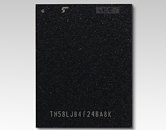Friday, July 20th 2018

Toshiba Develops 96-layer BiCS FLASH with QLC Technology
Toshiba Memory Corporation, the world leader in memory solutions, today announced that it has developed a prototype sample of 96-layer BiCS FLASH, its proprietary 3D flash memory, with 4-bit-per-cell (quad level cell, QLC) technology that boosts single-chip memory capacity to the highest level yet achieved.Toshiba Memory will start to deliver samples to SSD and SSD controller manufacturers for evaluation from the beginning of September, and expects to start mass production in 2019.
The advantage of QLC technology is pushing the bit count for data per memory cell from three to four and significantly expanding capacity. The new product achieves the industry's maximum capacity of 1.33 terabits for a single chip which was jointly developed with Western Digital Corporation. This also realizes an unparalleled capacity of 2.66 terabytes with a 16-chip stacked architecture in one package. The huge volumes of data generated by mobile terminals and the like continue to increase with the spread of SNS and progress in IoT, and the need to analyze and utilize that data in real time is expected to increase dramatically. That will require even faster than HDD, larger capacity storage and QLC products using the 96-layer process will contribute a solution.A packaged prototype of the new device will be exhibited at the 2018 Flash Memory Summit in Santa Clara, California, USA from August 6th to 9th.
Looking to the future, Toshiba Memory will continue to improve memory capacity and performance and to develop 3D flash memories that meet diverse market needs, including the fast expanding data center storage market.
The advantage of QLC technology is pushing the bit count for data per memory cell from three to four and significantly expanding capacity. The new product achieves the industry's maximum capacity of 1.33 terabits for a single chip which was jointly developed with Western Digital Corporation. This also realizes an unparalleled capacity of 2.66 terabytes with a 16-chip stacked architecture in one package. The huge volumes of data generated by mobile terminals and the like continue to increase with the spread of SNS and progress in IoT, and the need to analyze and utilize that data in real time is expected to increase dramatically. That will require even faster than HDD, larger capacity storage and QLC products using the 96-layer process will contribute a solution.A packaged prototype of the new device will be exhibited at the 2018 Flash Memory Summit in Santa Clara, California, USA from August 6th to 9th.
Looking to the future, Toshiba Memory will continue to improve memory capacity and performance and to develop 3D flash memories that meet diverse market needs, including the fast expanding data center storage market.

12 Comments on Toshiba Develops 96-layer BiCS FLASH with QLC Technology
This might be acceptable for SD cards, but not eMMC or SSDs.
But after a while, MLC became to be used for the Enterprise and Mission critical works.
Nowadays when you look at the product portfolio of the SSD manufacturers you will see nearly all the high end SSDs are MLC based.
We are not writing terabytes of data everyday.
Read endurance is unlimited for the SSDs.
So, for consumer use I do not think that QLC will cause problems.
Locate a 3D SSD into your laptop / PC and install your OS and forget everything & enjoy it.
Even the worst SSD is much better than the best HDD.
www.zdnet.com/article/ssd-endurance-death-by-petabyte/
:shadedshu:
Also, so nobody feels confused by this thread, "RGB".
You're welcome.
So yes, it is related.